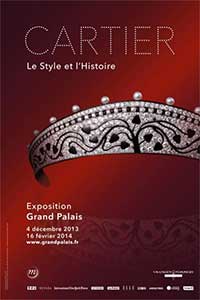 The most dazzling ornaments aren’t found in any Paris department store this year, instead you will need to head over to the newest exhibition to open at the Grand Palais, “Cartier: Style and History.” Conceived as a history of decorative arts, this show of breathless baubles tells not only the story of Cartier but also retraces the evolution of tastes, aesthetics and diversity of cultures within the jewelry industry as told through precious stones and metals.
The most dazzling ornaments aren’t found in any Paris department store this year, instead you will need to head over to the newest exhibition to open at the Grand Palais, “Cartier: Style and History.” Conceived as a history of decorative arts, this show of breathless baubles tells not only the story of Cartier but also retraces the evolution of tastes, aesthetics and diversity of cultures within the jewelry industry as told through precious stones and metals.
The exhibit is set within the walls of the newly renovated Salon d’Honneur of the Grand Palais which just reopened. A backlit custom-built stand fitted to accommodate the display cases and documents provides the central structure of the exhibition. Carefully placed spotlights keep each jewelry setting the focal point of attention within the sumptuous Art Nouveau interiors of the venue, draped in a light show of virtual jewels and exotic lands.These wall animations transform the architectural backdrop into a tableau of mirages in which glimpses of India, Egypt and China melt into a fantasy world of luxury reminiscent of the Café Society era.
Cartier’s story is told in eight episodes: the firm’s early days (1847-1905); the modern style (a trip through the 1920s; Art Deco); new horizons (inspiration from exotic lands, Egypt India, Persia); the mystery clocks; geometric luxury; the splendor of stones; Stylistic Freedom (muses of the house); and the origins of the Panther (fetish and symbol of Cartier).
Some 600 items of jewelry, watches, miniature objects, and clocks, complemented by paintings, haute couture garments, fashion magazines, lithographic works, and original conceptual illustrations, provide a rare and precious glimpse into the ornamentation of the super wealthy from the Second Empire through the 1970s. Among the items on display: 28 diamond studded tiaras, crowns and garlands, 18 mystery clocks, and 294 documents from Cartier’s own archives. And while the clarity and brilliance of the diamonds is spellbinding, the strength of this exhibition lies in part, on the homage it pays to its famous clients who contributed to the evolution of Cartier’s style and aesthetics throughout the years.
Cartier’s frequent customers included Daisy Fellowes, heiress to the Singer Sewing machine fortune, Wallis Simpson, the Duchess of Windsor, Marjorie Merriweather Post, sole heritor of the Post cereal company and later Elizabeth Taylor, Princess Grace of Monaco, and socialite Barbara Hutton. A separate corner is dedicated to each iconic client, complete with a sampling of jewelry ordered by them, as well as photos.
 Some of the more spectacular pieces on display include a 478 carat cushion cut sapphire, once owned by Queen Marie of Romania. It is the largest cut sapphire in the world. Another attention grabber: a restored version of the necklace commissioned by the Maharajah of Patiala in 1925, who deposited thousands of stones to be set a new way. Cartier was obliged to respect traditional Indian forms while incorporating Art Deco designs. Though this bib necklace was later dismantled (its remnants found in a cheap jewelry store), Cartier restored the original sparkle using synthetic stones and traditional methods of assembly.
Some of the more spectacular pieces on display include a 478 carat cushion cut sapphire, once owned by Queen Marie of Romania. It is the largest cut sapphire in the world. Another attention grabber: a restored version of the necklace commissioned by the Maharajah of Patiala in 1925, who deposited thousands of stones to be set a new way. Cartier was obliged to respect traditional Indian forms while incorporating Art Deco designs. Though this bib necklace was later dismantled (its remnants found in a cheap jewelry store), Cartier restored the original sparkle using synthetic stones and traditional methods of assembly.
Not all of Cartier’s legacy was super sized. The jeweler also triumphed with small mechanic knick-knacks, like Lilliputian sized clocks or bedazzled box-cameras created for the whimsy of the wealthy.
Cartier’s “Mystery Clocks” provide another axis to this exhibition. Some 100 clocks were produced by Cartier between 1912-1930. The Model A clock was a striking rarity when it suddenly appeared on the scene. It’s secret mechanism was sufficiently fascinating that no special decoration was required. Still people failed to realize that each of the hands was built into its own crystal disc which rotated thanks to a system of notches hidden within the frame. As the secret became known, the clocks became more complex and featured more poetic and exotic elements.
For anyone visiting Paris within the next two months, this exhibition provides a fascinating look at France’s most illustrious high-fashion jewelry house. Can’t make it but would like to see more? Head over to www.grandpalais.fr/evenment/Cartier-le-style-et-lhistoire. An iPhone app with HD images is also available at the App Store.
“Cartier: Le Style et l’Histoire,” Grand Palais. To February 16, 2014. Open Wed-Mon 10am-8pm. Closed Tues. (Christmas hours: Dec21-Jan 4: 9am-10pm). Entry: 11€

